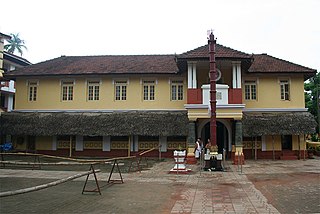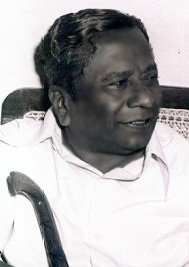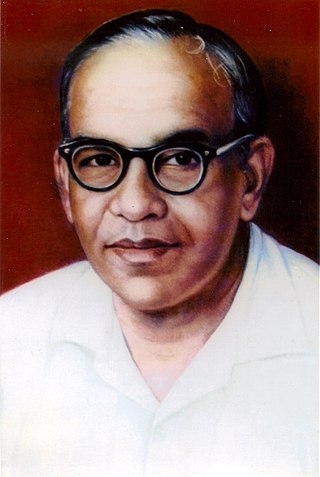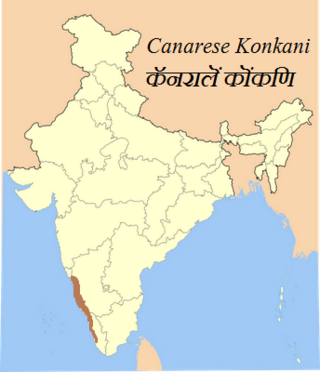
The Kashmiri Pandits are a group of Kashmiri Hindus and a part of the larger Saraswat Brahmin community of India. They belong to the Pancha Gauda Brahmin group from the Kashmir Valley, located within the Indian union territory of Jammu and Kashmir. Kashmiri Pandits are Hindu Kashmiris native to the Kashmir Valley, and the only remaining Hindu Kashmiris after the large-scale conversion of the Valley's population to Islam during medieval times. Prompted by the growth of Islamic militancy in the valley, large numbers left in the exodus of the 1990s. Even so, small numbers remain.

The Konkan is a stretch of land by the western coast of India, bound by the river Daman Ganga at Damaon in the north, to Anjediva Island next to Karwar town in the south; with the Arabian Sea to the west and the Deccan plateau to the east. The hinterland east of the coast has numerous river valleys, riverine islands and the hilly slopes known as the Western Ghats; that lead up into the tablelands of the Deccan. The region has been recognised by name, since at least the time of Strabo in the third century CE. It had a thriving mercantile port with Arab tradesmen from the 10th century. The best-known islands of Konkan are Ilhas de Goa, the site of the Goa state's capital at Panjim; also, the Seven Islands of Bombay, on which lies Mumbai, the capital of Maharashtra and the headquarters of Konkan Division.

Pandit Bhimsen Gururaj Joshi, also known by the honorific prefix Pandit, was one of the greatest Indian vocalists in the Hindustani classical tradition from Indian subcontinent. He is known for the khayal form of singing, as well as for his popular renditions of devotional music. Joshi belongs to the Kirana gharana tradition of Hindustani Classical Music. He is noted for his concerts, and between 1964 and 1982 Joshi toured Afghanistan, Italy, France, Canada and USA. He was the first musician from India whose concerts were advertised through posters in New York City. Joshi was instrumental in organising the Sawai Gandharva Music Festival annually, as homage to his guru, Sawai Gandharva.
Torke is a small village in Kumta taluk of Uttara Kannada district, Karnataka, India. This village is about a few square kilometres in extent. Torke traditionally is the amalgamation of Hoskatt, Naranapur, Toregazani, Torke, Devarabhavi, Hallergudi, Devana and Gonehalli. It has a Gram Panchayat.
Saraswat Brahmins are spread over widely separated regions spanning from Kashmir and Punjab in North India to Konkan in West India to Kanara and Kerala in South India. In places such as western and southern India, the claim of Brahminhood of some communities who claim to be Saraswat Brahmins is disputed. The word Saraswat is derived from the Rigvedic Sarasvati River.
Kashinath Trimbak Telang was an Indologist and Indian judge at Bombay High Court.
Gaud Saraswat Brahmins (GSB), also known as Shenvis are a Hindu community of contested caste status and identity. They primarily speak Konkani and its various dialects as their mother tongue.

Shri Chitrapur Math is the central math for the Chitrapur Saraswat Brahmin sect. It has been located at Shirali in the Bhatkal Taluk in the North Kanara district of Karnataka since 1757. The other maths of the community are located in Gokarna, Karla, Mangalore and Mallapur. All of the maths have the insignia of the saffron flag.
Shenoy is a surname from coastal Karnataka and Goa in India. It is found among Hindus of the Goud Saraswat Brahmin community following Smartha Sampradaya of Kavale Matha or Madhva Sampradaya of either Gokarna Matha or Kashi Matha.
Swami Shankarāshram II was the fourth head guru or Mathādhipati of the Chitrapur Saraswat Brahmin community. He reigned from 1770 to 1785.
Chitrapur is a village in Bhatkal Taluka, Uttar Kannada District, Karnataka, India. The religious headquarters of the Chitrapur Saraswat Brahmins, is in this town. The town, initially a small village was improved upon under the guidance of the Saraswat swamis. The small village of Chitrapur was built according to the idea of town-planning with a road in the middle and houses and gardens on both sides. It became a miniature municipality with street lamps lit during the night and roads swept clean. The mathadhipatis also constructed the Shiv-Ganga Sarovar at Chitrapur, the erection of a storeyed building at Panchavati, starting of schools for boys and girls. They helped build a post office with quarters for the post-master and a vegetable market at Chitrapur. The Chitrapur Math has many ancient Hindu statues in a museum.

Yashwant Vithoba Chittal was a Kannada fiction writer. G. S. Amur said: "His short stories, many of them were outstanding, and came with his distinct touch.The kind of experimentation he did with language, style and narrative is unparalleled."

Subbanna R. Ekkundi (1923–1995) was a recipient of Sahitya Akademi Award, National Award for Teacher and Soviet Land Award.
Bankikodla and Hanehalli are the twin neighbouring villages in a valley in Uttara Kannada district in the Indian state of Karnataka.
Gibb High School, Kumta, is an independent secondary school in Karnataka, India.

Vaman Srinivas Kudva, popularly called V. S. Kudva, was a founding director of Syndicate Bank, one of the oldest and major commercial banks of India.

Canarese Konkani are a set of dialects spoken by minority Konkani people of the Canara sub-region of Karnataka, and also in Kassergode of Kerala that was part of South Canara.
Panje Mangesh Rao (1874–1937) was an Indian writer and poet who wrote short stories, essays, poems and children's rhymes in Kannada. He is known as 'kavishishya'. He wrote Huthariya haadu, Naagara haave, Koti chennaya, Gudugudu Gummata Devaru, Maathaado raamappa.

Madhva Brahmins, are communities of Hindus from the Brahmin caste in India, who follow Sadh Vaishnavism and Dvaita philosophy propounded by Madhvacharya. They are found mostly in the Indian states of Karnataka, Maharashtra, Goa, Tamil Nadu, Kerala, Telangana and Andhra Pradesh.












